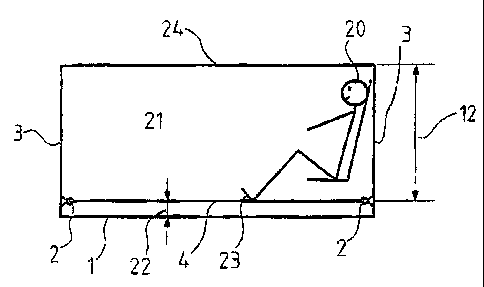Some of the information on this Web page has been provided by external sources. The Government of Canada is not responsible for the accuracy, reliability or currency of the information supplied by external sources. Users wishing to rely upon this information should consult directly with the source of the information. Content provided by external sources is not subject to official languages, privacy and accessibility requirements.
Any discrepancies in the text and image of the Claims and Abstract are due to differing posting times. Text of the Claims and Abstract are posted:
| (12) Patent: | (11) CA 2402753 |
|---|---|
| (54) English Title: | SAFETY FLOOR IN ARMOURED VEHICLES |
| (54) French Title: | PLANCHER DE SECURITE POUR VEHICULES BLINDES |
| Status: | Term Expired - Post Grant Beyond Limit |
| (51) International Patent Classification (IPC): |
|
|---|---|
| (72) Inventors : |
|
| (73) Owners : |
|
| (71) Applicants : |
|
| (74) Agent: | SMART & BIGGAR LP |
| (74) Associate agent: | |
| (45) Issued: | 2010-05-25 |
| (22) Filed Date: | 2002-09-11 |
| (41) Open to Public Inspection: | 2003-03-14 |
| Examination requested: | 2007-08-16 |
| Availability of licence: | N/A |
| Dedicated to the Public: | N/A |
| (25) Language of filing: | English |
| Patent Cooperation Treaty (PCT): | No |
|---|
| (30) Application Priority Data: | ||||||
|---|---|---|---|---|---|---|
|
An apparatus is proposed for protecting the crew 20 of an armoured vehicle from mines by providing an intermediate floor 4 above the vehicle floor 1, wherein the intermediate floor 4 may be lowered e.g. when the vehicle is stationary so that, for climbing out and sitting up, the crew is not adversely affected by a reduced internal clearance height.
Est proposé un appareil pour protéger l'équipage 20 d'un véhicule blindé contre les mines. L'appareil est constitué d'un plancher intermédiaire 4 posé par-dessus le plancher du véhicule 1, lequel plancher intermédiaire 4 peut être abaissé, c'est-à-dire quand le véhicule est stationnaire, de sorte que pour descendre du véhicule ou se relever, l'équipage n'est pas gêné par une hauteur libre intérieure réduite.
Note: Claims are shown in the official language in which they were submitted.
Note: Descriptions are shown in the official language in which they were submitted.

2024-08-01:As part of the Next Generation Patents (NGP) transition, the Canadian Patents Database (CPD) now contains a more detailed Event History, which replicates the Event Log of our new back-office solution.
Please note that "Inactive:" events refers to events no longer in use in our new back-office solution.
For a clearer understanding of the status of the application/patent presented on this page, the site Disclaimer , as well as the definitions for Patent , Event History , Maintenance Fee and Payment History should be consulted.
| Description | Date |
|---|---|
| Inactive: Expired (new Act pat) | 2022-09-12 |
| Common Representative Appointed | 2019-10-30 |
| Common Representative Appointed | 2019-10-30 |
| Change of Address or Method of Correspondence Request Received | 2018-03-28 |
| Grant by Issuance | 2010-05-25 |
| Inactive: Cover page published | 2010-05-24 |
| Pre-grant | 2010-02-24 |
| Inactive: Final fee received | 2010-02-24 |
| Notice of Allowance is Issued | 2009-10-07 |
| Letter Sent | 2009-10-07 |
| Notice of Allowance is Issued | 2009-10-07 |
| Inactive: Approved for allowance (AFA) | 2009-09-15 |
| Amendment Received - Voluntary Amendment | 2009-07-23 |
| Inactive: S.30(2) Rules - Examiner requisition | 2009-01-23 |
| Letter Sent | 2007-09-04 |
| Request for Examination Requirements Determined Compliant | 2007-08-16 |
| All Requirements for Examination Determined Compliant | 2007-08-16 |
| Request for Examination Received | 2007-08-16 |
| Inactive: IPC from MCD | 2006-03-12 |
| Application Published (Open to Public Inspection) | 2003-03-14 |
| Inactive: Cover page published | 2003-03-13 |
| Letter Sent | 2003-03-12 |
| Inactive: Single transfer | 2003-01-20 |
| Inactive: First IPC assigned | 2002-11-15 |
| Inactive: Courtesy letter - Evidence | 2002-10-29 |
| Inactive: Filing certificate - No RFE (English) | 2002-10-23 |
| Filing Requirements Determined Compliant | 2002-10-23 |
| Application Received - Regular National | 2002-10-22 |
There is no abandonment history.
The last payment was received on 2009-08-24
Note : If the full payment has not been received on or before the date indicated, a further fee may be required which may be one of the following
Please refer to the CIPO Patent Fees web page to see all current fee amounts.
Note: Records showing the ownership history in alphabetical order.
| Current Owners on Record |
|---|
| RHEINMETALL LANDSYSTEME GMBH |
| Past Owners on Record |
|---|
| HELLMUT PITTINGER |
| RALF BOTTCHER |